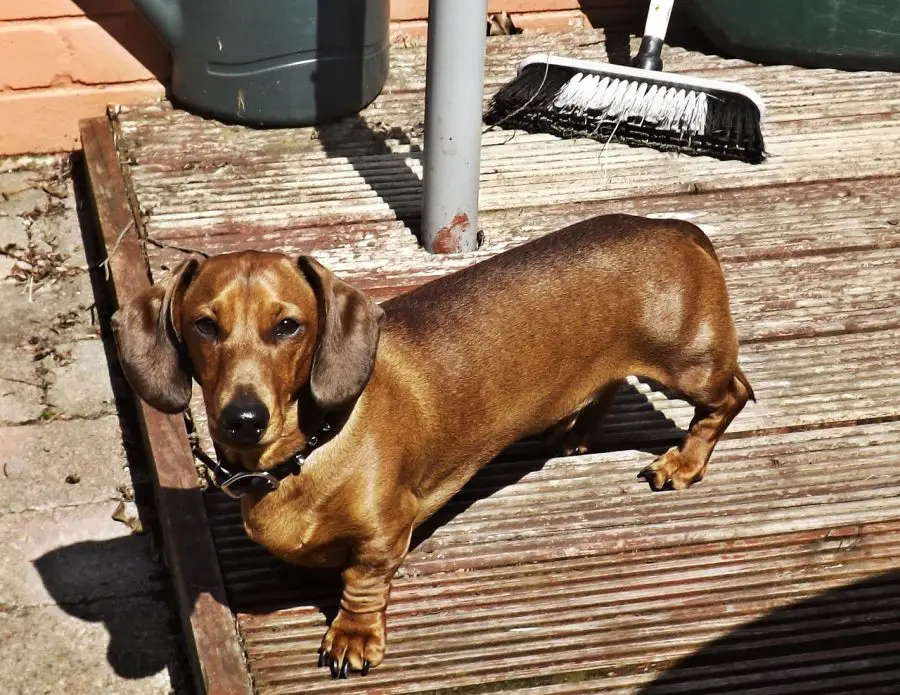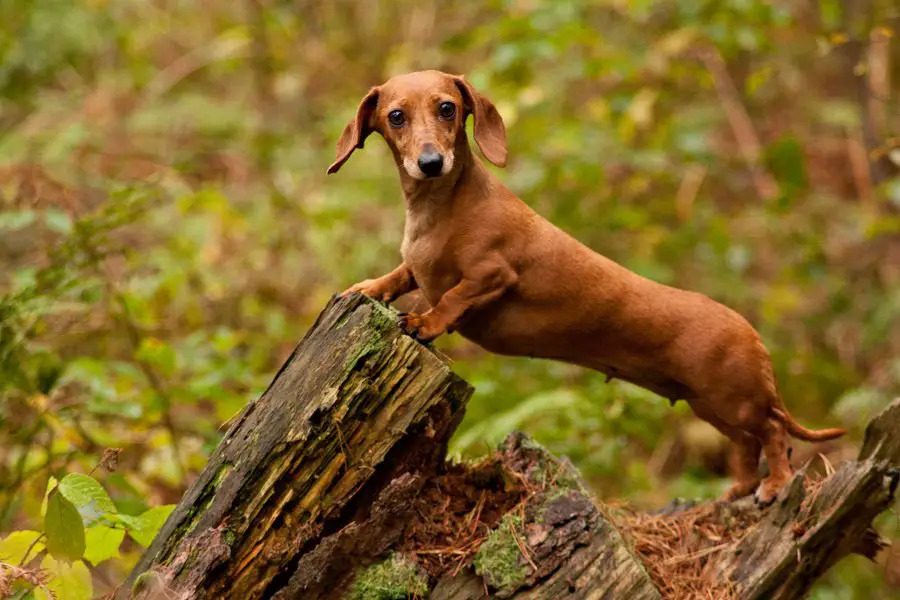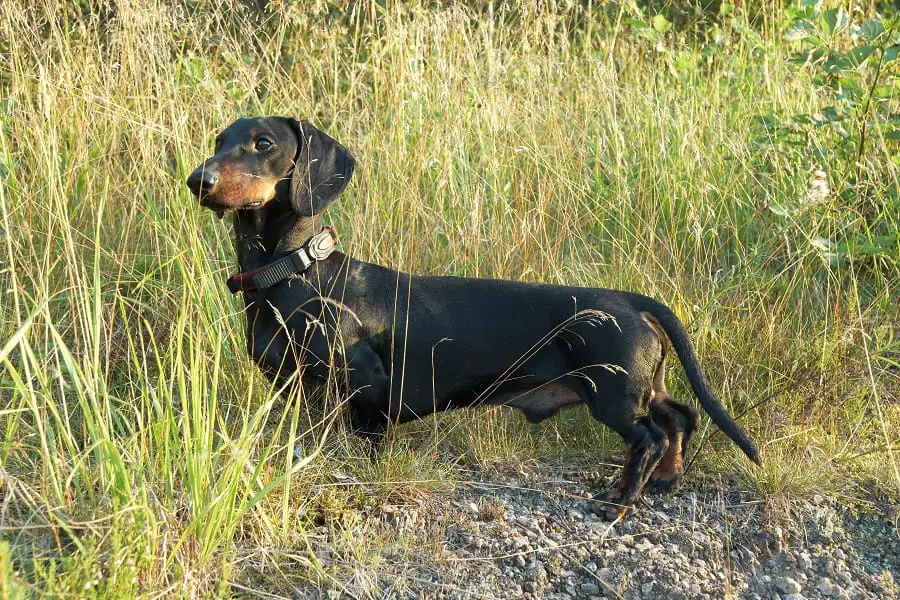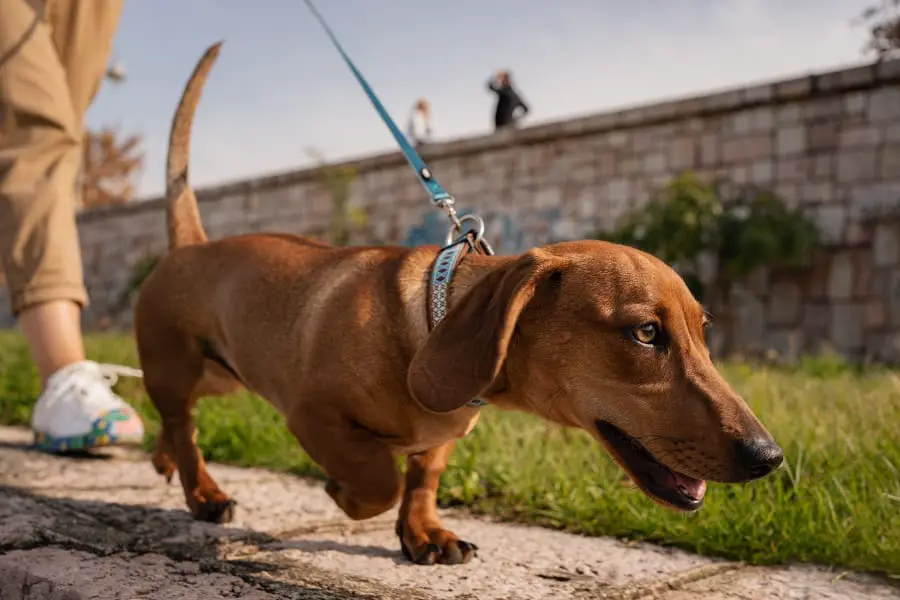Of all the distinguishing characteristics of different dog breeds – the spots on a Dalmatian, the dreadlocks of a Komondor or the facial features of a Pug – one of the most widely known and easily identifiable is the long body of a Dachshund.
Even people otherwise unfamiliar with dogs would not find it difficult to recognize a dachshund because of the breed’s unique body structure, easy to mark out from other small dogs.
 This peculiar trait has also earned the breed some common nicknames like the ‘sausage dog’ or the ‘wiener dog’.
This peculiar trait has also earned the breed some common nicknames like the ‘sausage dog’ or the ‘wiener dog’.
But have you wondered why dachshunds have long bodies in the first place? Is this just a freak accident of nature or a consciously developed feature meant to serve a purpose?
And, even more important for dog owners, does it have a bearing on how a dachshund is cared for?
As we will see in this post, not only the long body of the dachshund, but even its droopy ears, short legs and long, sturdy tail were all developed to serve a specific purpose.
A clue to this purpose lies in the breed’s name itself – ‘Dachs’ is German for badger and ‘hund’ is the German word for dog.
Towards the end of the post, we will also take a brief look at how a dachshund’s long body makes it susceptible to certain ailments, requiring extra care from owners.
Physiology
 The dachshund owes its characteristic dwarf-like appearance to a condition known as osteochondrodysplasia.
The dachshund owes its characteristic dwarf-like appearance to a condition known as osteochondrodysplasia.
Quite a mouthful, that word! ‘Osteo’ is a word of Greek origin, referring to bones, while ‘chondro’ refers to cartilages. ‘Dysplasia’ is a general medical term used to refer to abnormal development of a tissue or organ.
So, the abnormal growth of bones and cartilages gives dachshunds as well as some other breeds, like Corgis and Basset Hounds, their short legs.
While short-legged dogs have found mention in hunting lore for thousands of years, this feature, as was discovered fairly recently at Maryland’s National Human Genome Research Institute, is a result of a single mutation event that occurred only a few hundred years ago.
The mutation caused an extra copy of a gene to be acquired, which, in turn, causes the overproduction of a protein that affects growth during the development of the fetus.
The presence of this mutation in the dog genetic pool allowed dog breeders to easily develop small-sized breeds.
Designed for Hunting
Now, why were small-sized breeds useful? Given the traditional role of dogs as hunters and guards, larger, ferocious specimens would be expected to be more desirable.
But, hunting often involved smaller quarry like badgers and rabbits, and it was found that small-sized dogs were better equipped to move fast through thick foliage and pursue these cunning animals into their burrows.

Smaller-legged dogs were also easier to follow on horseback or on foot.
Apart from the short legs, and in a way because of them, a long body was also found to be helpful in hunting.
It gave dogs the heft needed to fight badgers and other small animals that might respond to danger with a fierce counter-attack.
The low height was counterbalanced by the power and weight provided by the long body.
Plus, the long body made it easier for such dogs to access deep burrows while keeping their hind legs on firm ground for support.
It was easier for hunters to pull the dog out if part of its body was still outside the hole.
A long body also made the spine of a dachshund relatively more flexible, making it easy for the dog to wriggle into tight holes.
Add other desirable features like paws meant for digging, a long tail that helps in locating and pulling the dog, droopy ears that trap scent molecules, and sharp nails and teeth, and it is easy to see why dachshunds made for some mean hunting machines.
In fact, dachshunds are the smallest breed of dogs developed specifically for hunting.
All these physical features were deliberately and selectively bred for.
There is no consensus regarding this, but it is widely believed that early Dachshunds were developed in the 15th century by crossing short-legged, long-bodied dogs like Beagles and Basset Hounds with breeds adept at digging and hunting vermin, like Terriers.
Variations like the length of hair or size of the dog were introduced into different bloodlines depending on the prey they were to be used to hunt or the conditions they were meant to function in.
For example, miniature dachshunds are believed to have been bred to hunt smaller prey, like rabbits.
The different varieties of the breed reached refinement around the late 1800s and early 1900s, which was the time when breed standards were drawn and cross-breeding began to be discouraged.
Health Challenges
But the same long body that makes your dachshund perfect for hunting can also lead to certain health-related challenges.
Dachshunds are particularly prone to spinal issues, especially intervertebral disk disease or IVDD.
IVDD, which affects the disks in the spinal column, causes pain for a prolonged duration and can lead to permanent damage to the spine and even paralysis.
According to studies, approximately 25% of dachshunds suffer from damage to spinal disks severe enough to require veterinary attention.
There may be many cases where the pain is not recognized because of low severity.
The disease can be treated in some cases with the help of steroids and non-steroidal anti-inflammatory drugs.
Surgery might be required in more serious cases. It is also strongly advised to not use dogs that have developed the disease before 2 years of age in breeding as this is an inherited condition.
Apart from back problems, other bone related health issues seen in dachshunds include patellar luxation, which is the dislocation of the kneecap, and osteogenesis imperfecta, more commonly known as brittle bone disease.
Special care
The potential issues related to the long body and the overall bone structure of dachshunds makes it necessary to take measures to prevent undue strain.
Dachshunds love to eat and their sharp sense of smell helps them detect food easily.
But you need to steel your heart and not give in to those large, pleading eyes, limiting your pet’s food intake to the recommended quantity.
Being overweight can put extra strain on the already delicate spine.
Despite their small size, dachshunds require regular exercise. One of the ways it helps is by keeping their muscles strong enough to provide support to the back.

One or two walks of moderate length everyday should achieve this.
While they should be allowed free movement around the house, keep them from running up and down the stairs or jumping on or off furniture to avoid injury to their backbone.
Dachshunds are also very social and a big hit with children.
But, while playing with the dog or while just trying to stand up, a young child can often unknowingly put an inordinate amount of its own body weight on the dog’s back.
This might not be an issue for larger dogs like Labradors, but can be potentially damaging for a dachshund’s bone structure.
So, you need to be extra cautious when a kid around you is playing with a dachshund.
Dachshunds are very hardy otherwise, and have pretty much no other breed specific ailments.
Therefore, as long as you are conscious of these few special needs, your dog can easily live the long, healthy life it is meant to.
Moreover, it will help it stay happy and an active member of the household.
After all its long body or other distinctive physical features are not the only remnants of its hunting days.
Equally important in succeeding as a hunter were its intelligence and temperament – courage, outgoing nature, devotion to its pack – all qualities that have ensured its long-standing popularity as a companion and family dog in our non-hunting times.
